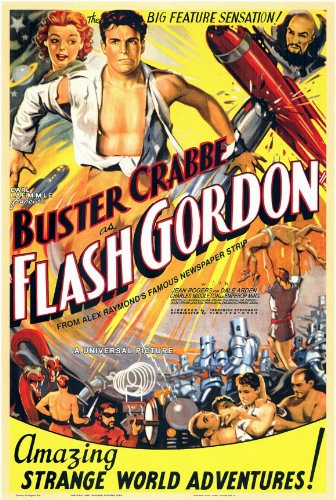Previous FilmFlash Gordon - Rocket Ship
Next FilmFlash Gordon - Trip to Mars
Flash Gordon - Space Soldiers 1936
 | Three earthlings visit the planet Mongo to thwart the evil schemes of Emperor Ming the Merciless. |
The Cast
| Buster Crabbe | - | Flash Gordon |
| Jean Rogers | - | Dale Arden |
| Charles Middleton | - | Ming the Merciless |
| Priscilla Lawson | - | Princess Aura |
| Frank Shannon | - | Dr. Alexis Zarkov |
| Richard Alexander | - | Prince Barin [Chs. 5-13] |
| Jack 'Tiny' Lipson | - | King Vultan [Chs. 5-13] |
| Theodore Lorch | - | High Priest #2 [Chs. 8-11, 13] |
Film Trivia
Despite its large budget, this serial utilized many sets from other Universal films, such as the laboratory and crypt set from Bride of Frankenstein (1935), the castle interiors from Dracula's Daughter (1936), the idol from The Mummy (1932) and the opera house interiors from The Phantom of the Opera (1925). In addition, the outer walls of Ming's castle were actually the cathedral walls from The Hunchback of Notre Dame (1923).
The serial was shot in six weeks with the cast and crew working many fourteen hour days.
The entire four hour serial was shot in six weeks with an average of 85 set-ups a day.
This serial's budget of $360,000 was three times more than was typically allotted for a chapter play at the time.
King Features Syndicate released the three Flash Gordon serials to US TV in 1951. Because the television show Flash Gordon (1954), starring Steve Holland as Flash, was in syndication in late 1953, the three Universal Pictures' Flash Gordon theatrical serials were retitled for TV broadcast. Flash Gordon (1936) became "Space Soldiers", Flash Gordon's Trip to Mars (1938) became "Space Soldiers' Trip to Mars", and Flash Gordon Conquers the Universe (1940) became "Space Soldiers Conquer the Universe". To this day both the three original "Flash Gordon" serial titles and the three "Space Soldiers" titles are used.
The rocket was originally constructed for the 1930 sci-fi comedy Just Imagine (1930). That film was also the source of a brief scene of dancing girls swarming over an idol with moving arms, which Ming views over a TV screen.
Chapter Titles:
- 1. The Planet of Peril
- 2. The Tunnel of Terror
- 3. Captured by the Shark Men
- 4. Battling the Sea Beast
- 5. The Destroying Ray
- 6. Flaming Torture
- 7. Shattering Doom
- 8. Tournament of Doom
- 9. Fighting the Fire Demon
- 10. The Unseen Peril
- 11. In the Claws of the Tigron
- 12. Trapped in the Turrett
- 13. Rocketing To Earth
Stock footage shown of Flash's return to Earth includes newsreel footage of the madding crowds that gathered for Charles Lindbergh's landing in Paris on May 21, 1927.
The characters and storyline of this first of 3 Flash Gordon serials are the ones that most adhered to in the theatrical remake of Flash Gordon (1980), starring Sam J. Jones as Flash.
The opening music for the episodes as well as some of the music for the action scenes are excerpts from the classical work "Symphonic Poem, Les Preludes", by Franz Liszt. In Chapter One Richard Wagner's "Good Friday Prelude" to "Parsifal" is used.
According to film historian Roy Kinnard, the serial played at evening performances, not just matinées, the usual time period to run chapter plays.
At the time of his death on October 1, 2008, House Peters Jr. (Shark Man) was the last surviving cast member of the serial.
This was originally the longest film to be preserved at the National Film Registry, until Empire (1965) was preserved eight years later.
The noises of the rocket ships propulsion sound suspiciously like propeller aircraft of the day. It stands to reason as rockets and jets didn't yet exist and probably met 1936 audience expectations of propulsion sounds.
Music from other films were utilized effectively including W. Franke Harling's "The Invisible Man," Heinz Roemheld's "The Black Cat," and Karl Hajos' "Werewolf of London."
Buster Crabbe (Flash Gordon), Charles Middleton (Ming the Merciless) and Frank Shannon (Dr. Alexis Zarkov) are the only actors to appear in all three "Flash Gordon" serials.
The scenes of the slaves toiling in the atom furnaces were inspired by Metropolis (1927).
Lon Poff played the role of the first High Priest in the first few chapters but was uncredited. The scene in which he was executed by Ming the Merciless (Charles Middleton) was deleted, meaning that his replacement by Theodore Lorch as the second High Priest was unexplained. An urban legend has developed that Poff died during the production of the serial but, in reality, he did not die until 1952.
Jon Hall was considered for the role of Flash Gordon.
In 1934 Universal purchased the film rights to the most popular of King Features newspaper comic strips. Besides "Flash Gordon," "Secret Agent X-9," "Ace Drummond," "Tailspin Tommy,"and "Jungle Jim" were also included in the package.
The scene that closes out all three Flash Gordon serials is actually stock footage from a silent serial featuring a ticker tape parade.